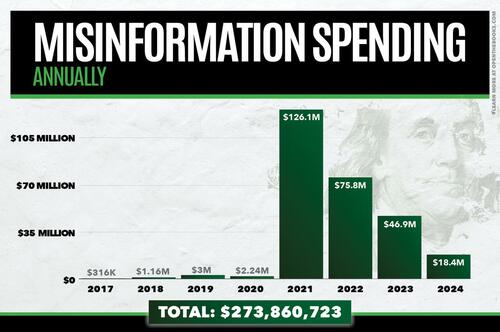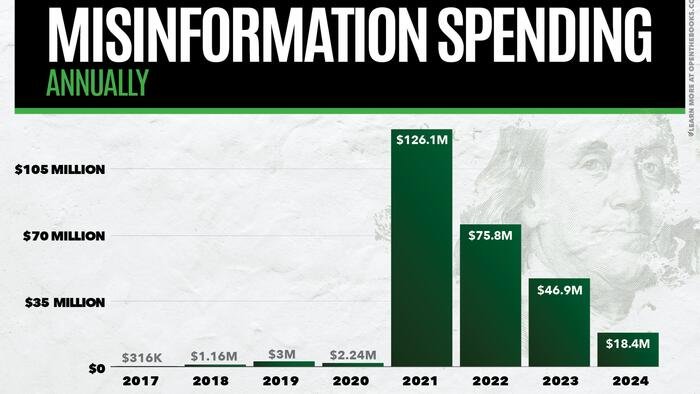Submitted by Open the Books
Campaign season brought with it a steady stream of accusations that various parties and platforms were spreading misinformation and disinformation.
Most recently, the scandals at FEMA over avoiding homes with Trump signs was quickly slapped with a “misinformation” label…until FEMA itself admitted it had happened. MSNBC anchor Jen Psaki suggested “laws have to change” to combat the scourge.
With the misinformation category being weaponized across the political spectrum, we took a look at how invested government has become in studying and “combatting” it using your tax dollars. That research can provide the intellectual ammunition to censor people online.
Since 2021, the Biden-Harris administration has spent $267 million on research grants with the term “misinformation” in the proposal.
Of course, the Covid pandemic was the driving force behind so much of the misinformation debate. Sure enough, the feds have spent at least $127 million in grants specifically targeted to study the spread of “misinformation” — or to help people “overcome” it, so to speak — by persuading them to go along with Covid-related public health recommendations and mandates.
In one particularly brazen instance, $200,000 was spent slandering President-elect Trump himself. The grant resulted in a paper suggesting populist leaders and movements in various countries kept people from coming together in “solidarity” and public officials need to have the “main say” on health guidance next time.
In other words, it would be better if your voice were silenced in favor of the “expert” class.
BACKGROUND
The COVID-19 pandemic instigated a rush of funding for research and projects addressing misinformation. At the time bureaucrats like Anthony Fauci contended that false information spread online undermined scientific recommendations coming from the government. Many of those government recommendations—vaccines for children, masking and double masking, and six feet for social distancing—have since been found to have dubious scientific basis.
The federal government used both carrots and sticks, in the form of grants and censorious pressure campaigns, in the name of combating COVID misinformation. At the same time, it was working hand in glove with social media companies to silence critics of repressive COVID-19 policies.
There is robust documentation by now proving that the Biden-Harris administration worked closely with social media companies to censor content deemed “misinformation,” which often included cases where people simply questioned or disagreed with the Administration’s COVID policies.
Earlier this year the Supreme Court ruled that such activities did not violate the First Amendment, but Meta CEO Mark Zuckerberg admitted such pressure was “wrong;” Tesla CEO Elon Musk purchased Twitter (now X) in part because of the company’s extreme restrictions on speech during COVID.
In February the U.S. House Committee on the Judiciary and the Select Subcommittee on the Weaponization of the Federal Government issued a scathing report against the National Science Foundation (NSF) for funding grants supporting tools and processes that censor online speech.
The report said, “the purpose of these taxpayer-funded projects is to develop artificial intelligence (AI)-powered censorship and propaganda tools that can be used by governments and Big Tech to shape public opinion by restricting certain viewpoints or promoting others.” $13 million was spent on the censorious technologies profiled in the report.
While the NSF was singled out for particularly egregious ideology-driven behavior, the full universe of misinformation-related spending in the federal government is much larger and goes far beyond colluding with the tech sector to restrict opinions online.
Federal spending records show at least $127 million tax dollars funding anti-misinformation efforts directly related to COVID-19 for a variety of activities, from on-the-ground advocacy working to dispel vaccine misinformation, to scientific studies on how supposed misinformation is spread online.
The result of all this was a record loss of trust in science and government and compounding economic and social disasters that may never be able to be fully quantified.
Learning to think critically and discern truth from lies is an important life skill, but the federal government has proven it is not capable of addressing that need responsibly. It’s the worst possible arbiter of truth, as it were, because it makes the state a gatekeeper of speech.
BY THE NUMBERS
Misinformation-related grants actually stretch back to FY2017 during the first Trump presidency. $273 million has been awarded for grant proposals containing the term since then—but there was an explosion of cash during the years-long Covid malaise. The vast majority of that figure ($267 million) was for grants that began in 2021 or later.
METHODOLOGY NOTE: This likely does not cover all grants given to combat misinformation, because transaction descriptions may not include this keyword, but the trend in spending illustrates a sudden explosion of interest in misinformation starting in 2021.
An enormous year-over-year jump in new grants occurred between 2020 and 2021—from $2.2 million to $126 million as the federal government poured money out to address COVID-related “misinformation,” among other projects.
While spending has since slowed down, it is still far higher than it was pre-pandemic in 2020: $18.3 million in new grants began in FY 2024.

Grants mostly came from the Department of Health and Human Services ($185 million), followed by the National Science Foundation ($65 million), with the Department of State ($12 million) in a distant third. CHART: Click here for a breakdown of misinformation spending by agency.
An additional $17 million has awarded to misinformation-related contracts since 2020, and again, most of it ($12.5 million) was in FY 2021.
WHAT IS MISINFORMATION, ANYWAY?
According to the Department of Health and Human Services website:
“Misinformation is information that is false, inaccurate, or misleading according to the best available evidence at the time.”
The website goes on to detail supposed issues with COVID-19 related misinformation:
“During the pandemic, health misinformation has led people to decline vaccines, reject public health measures, and use unproven treatments.
Health misinformation has resulted in harassment and violence towards frontline workers responsible for communicating public health measures. The definitions of “best available evidence” and “authoritative experts” are subjective and open to interpretation. For instance, Dr. Anthony Fauci admitted to Congress in January 2024 that the six feet social distancing rule lacked scientific basis and was arbitrarily imposed. This recommendation led to extended closures of schools and businesses, causing economic turmoil and learning setbacks for children.
Under the Trump administration, approximately $6.7 million was allocated for projects related to misinformation, primarily focusing on monitoring social media for false information. This initiative continued under the Biden-Harris administration, with over $127 million dedicated specifically for combating COVID-related misinformation. Funds were directed towards public advocacy campaigns and scientific studies aimed at understanding and countering misinformation online.
On-the-ground initiatives received millions of dollars to promote COVID vaccines and dispel misinformation, while research grants were awarded to universities to study the spread of false information and develop strategies to combat it. Examples include projects to track misinformation about COVID-19, address disparities in vaccine uptake, and develop algorithms to detect and counteract false information online.
Overall, the government’s efforts to combat misinformation encompassed a wide range of projects, from public health campaigns to academic research, with a significant focus on COVID-related misinformation. The study, titled “Pandemic Communication in Time of Populism: Building Resilient Media and Ensuring Effective Pandemic Communication in Divided Societies,” was awarded a grant of $199,516 from the National Science Foundation. Researchers examined how populist leaders hindered solidarity during the COVID pandemic, focusing on Trump’s presidency and leaders of three other countries. One researcher highlighted the high levels of polarization and politicization of pandemic responses in these countries, hindering society’s ability to unite and navigate the pandemic effectively.
The research recommended that experts should play a central role in public health crises, emphasizing the need for governments to prioritize expert advice in shaping society’s responses. The study also pointed to climate change as the next crisis requiring strong public solidarity, which populist leaders may struggle to foster.
In a similar vein, the National Academies of Science received a $994,950 grant from the National Science Foundation to address misinformation about science. The report aims to combat misinformation that undermines scientific expertise and facts in civic dialogue, reflecting a growing concern over the spread of misinformation in recent years.
However, questions remain about the potential lack of introspection in these reports, especially given the involvement of researchers like Kasisomayajula Viswanath, who previously emphasized the safety and effectiveness of COVID-19 vaccines. The report’s credibility may be called into question, particularly in light of shifting recommendations on childhood vaccinations in other countries.
Furthermore, contracts aimed at monitoring and eliminating misinformation have raised concerns about potential censorship and ideological bias. Some contracts focused on capturing and surveilling medical misinformation on social media platforms, while others aimed to systematically understand and eliminate misinformation online. Additionally, defense contractors received funding for analyzing misinformation, raising questions about the potential misuse of terms like “malinformation” to censor opposing viewpoints.
In conclusion, the allocation of public funds towards combating misinformation raises concerns about ideological motivations and the erosion of public trust in health messaging. Flawed messaging and contradictory recommendations have contributed to a collapse in public trust, highlighting the need for transparency and accountability in grant and contract spending related to misinformation. It remains essential for Americans to critically evaluate the information presented and question the underlying motivations behind efforts to combat misinformation.
The grant also funded a co-design camp focused on the Black Lives Matter movement, showcasing the use of a design kit to create interest-driven escape rooms. Play the escape room here.
How much of the spending on misinformation is purely ideological or promotes contested or false information?
It is no secret that the internet is flooded with misinformation that can mislead and cause unnecessary panic among readers. Thus far, it has been evident that the federal government is not equipped to address this issue impartially. It would be more prudent to cease such efforts altogether rather than risk further tarnishing federal credibility with allegations of bias and violations of First Amendment rights.
The incoming Trump administration should put an end to the government’s involvement in regulating what is deemed as misinformation, and Congress should withhold funding for such initiatives.
Otherwise, taxpayers could find themselves unknowingly supporting their own suppression.
Loading…
sentence in a different way:
The cat sat lazily in the sun, basking in its warmth.
The lazy cat lounged in the sun, enjoying the heat.

